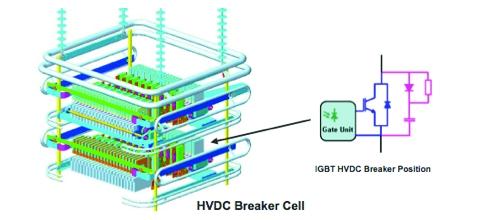
ABB breakthrough could enable European electrical
supergrid
Mar 1, 2013 - Stephen Harris
- theengineer.co.uk
“
European electricity grid operators have
entered 'serious
negotiations' with the developers of a technology
that could enable the creation of a continental supergrid.
Transmission system operators (TSOs) are examining
a breakthrough made by ABB that could help to more
efficiently and cheaply link renewable energy sources,
which tend to be in remote locations, to the rest
of the grid.
ABB said its high voltage direct current (HVDC)
circuit breaker is the first of its kind to work
quickly enough to allow safe operation of an HVDC
transmission network, which is seen as a possible
way to deal with the growing amount of renewable
energy generation.
'
There is a need to transport more energy across Europe,
both north/south and east/west,' said ABB technology
manager Per Skytt, speaking at a press conference.
'Over long distances, DC is more cost effective
than AC … It's also a more efficient
use of land because you can use lines that transmit
more power in the same space.'
Underwater HVDC cables are currently used to link
several European national grids with one another
and HVDC is expected to become even more important
as a way of connecting multiple wind, solar or hydro-electric
plants and transporting their energy across the continent.
Internal HVDC lines are already being rolled out
in Germany, where the decision to close down nuclear
power plants will leave the energy-intensive industrial
south of the country with a shortage of nearby power.
But these kind of lines can only connect
two individual points and can't be linked
in a mesh network because pre-existing HVDC circuit
breaker technology
relies on mechanical systems that interrupt the flow
of current for so long (tens of milliseconds) that
it would destabilise such a grid.
The problem of how to break DC transmission circuits
without significantly disrupting their operation
has challenged engineers for over 100 years and was
a factor in the dominance of AC transmission for
most of the 20th century.
AC circuits are easier to break because the oscillation
of their energy flow means current is regularly reduced
to zero, at which point the circuit can be broken
without causing disruption.
And faults tend to propagate more quickly
across HVDC networks because they aren't
interrupted by transformers, increasing the importance
of breakers.

Source: ABB
ABB's hybrid circuit breaker features a physical
disconnector and current arrester banks.
To solve the problem for HVDC, ABB developed a hybrid
system that resets a circuit in fewer than five milliseconds
and with less than 0.01 per cent energy loss, small
enough not to cause problems for the network.
When a fault such as a power surge from
a lightning strike is detected on the line, the
circuit breaker's
switch shifts current flow from its primary path
to a secondary path comprised of semiconductors.
A disconnector on the main path driven by magnetic
actuators then opens and closes to reset the voltage
and the current is shifted again into a bank of arresters,
which absorb the excess energy. The current can then
be returned to its original path.
'The disconnector operates around 50 times
faster than anything available today,' said
Skytt.
ABB has tested the circuit breaker in the lab at
the 320kV level typically used by HVDC lines and
plans to test it in the field over the next two years.
Skytt said the company was in 'serious negotiations' with
European TSOs about deploying the breaker since it
was announced in November 2012.

|



